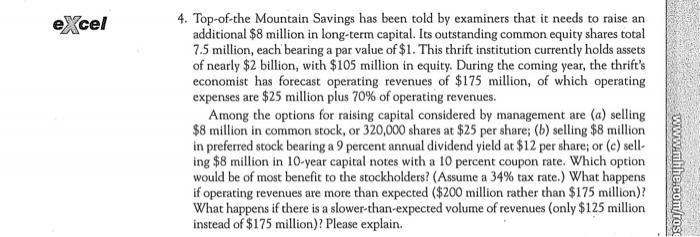4. Top-of-the Mountain Savings has been told by examiners that it needs to raise an additional $8 million in long-term capital. Its outstanding common equity shares total 7.5 million, each bearing a par value of $1. This thrift institution currently holds assets of nearly $2 billion, with $105 million in equity. During the coming year, the thrift's economist has forecast operating revenues of $175 million, of which operating expenses are $25 million plus 70% of operating revenues. Among the options for raising capital considered by management are (a) selling $8 million in common stock, or 320,000 shares at $25 per share; (b) selling $8 million in preferred stock bearing a 9 percent annual dividend yield at $12 per share; or (c) sell- ing $8 million in 10-year capital notes with a 10 percent coupon rate. Which option would be of most benefit to the stockholders? (Assume a 34% tax rate.) What happens if operating revenues are more than expected ($200 million rather than $175 million)? What happens if there is a slower-than-expected volume of revenues (only $125 million 1 instead of $175 million)? Please explain. 5. Please calcula excel 4. Top-of-the Mountain Savings has been told by examiners that it needs to raise an additional $8 million in long-term capital. Its outstanding common equity shares total 7.5 million, each bearing a par value of $1. This thrift institution currently holds assets of nearly $2 billion, with $105 million in equity. During the coming year, the thrift's economist has forecast operating revenues of $175 million, of which operating expenses are $25 million plus 70% of operating revenues. Among the options for raising capital considered by management are (a) selling $8 million in common stock, or 320,000 shares at $25 per share; (b) selling $8 million in preferred stock bearing a 9 percent annual dividend yield at $12 per share; or (e) sell- ing $8 million in 10-year capital notes with a 10 percent coupon rate. Which option would be of most benefit to the stockholders? (Assume a 34% tax rate.) What happens if operating revenues are more than expected ($200 million rather than $175 million)? What happens if there is a slower-than-expected volume of revenues (only $125 million instead of $175 million)? Please explain. www.mhhe.com/rose








